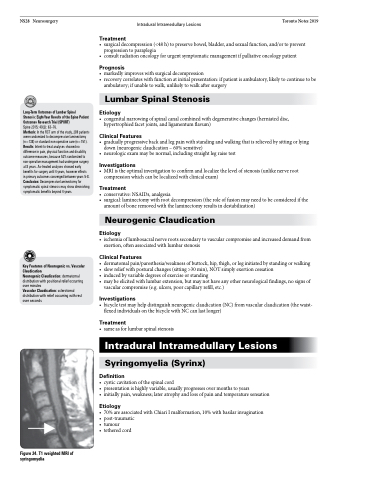Page 826 - TNFlipTest
P. 826
NS28 Neurosurgery
Intradural Intramedullary Lesions Toronto Notes 2019
Long-Term Outcomes of Lumbar Spinal
Stenosis: Eight-Year Results of the Spine Patient Outcomes Research Trial (SPORT)
Spine 2015; 40(2): 63–76.
Methods: In the RCT arm of the study, 289 patients were randomized to decompressive laminectomy (n=138) or standard non-operative care (n=151). Results: Intent-to-treat analyses showed no difference in pain, physical function and disability outcome measures, because 52% randomized to non-operative management had undergone surgery at 8 years. As-treated analyses showed early benefits for surgery until 4 years, however effects in primary outcomes converged between years 5-8. Conclusion: Decompressive laminectomy for symptomatic spinal stenosis may show diminishing symptomatic benefits beyond 4 years.
Key Features of Neurogenic vs. Vascular Claudication
Neurogenic Claudication: dermatomal distribution with positional relief occurring over minutes
Vascular Claudication: sclerotomal distribution with relief occurring with rest over seconds
Treatment
• surgicaldecompression(<48h)topreservebowel,bladder,andsexualfunction,and/ortoprevent progression to paraplegia
• consultradiationoncologyforurgentsymptomaticmanagementifpalliativeoncologypatient
Prognosis
• markedlyimproveswithsurgicaldecompression
• recoverycorrelateswithfunctionatinitialpresentation:ifpatientisambulatory,likelytocontinuetobe
ambulatory; if unable to walk, unlikely to walk after surgery
Lumbar Spinal Stenosis
Etiology
• congenitalnarrowingofspinalcanalcombinedwithdegenerativechanges(herniateddisc, hypertrophied facet joints, and ligamentum flavum)
Clinical Features
• gradually progressive back and leg pain with standing and walking that is relieved by sitting or lying down (neurogenic claudication – 60% sensitive)
• neurologicexammaybenormal,includingstraightlegraisetest
Investigations
• MRI is the optimal investigation to confirm and localize the level of stenosis (unlike nerve root compression which can be localized with clinical exam)
Treatment
• conservative: NSAIDs, analgesia
• surgical:laminectomywithrootdecompression(theroleoffusionmayneedtobeconsideredifthe
amount of bone removed with the laminectomy results in destabilization)
Neurogenic Claudication
Etiology
• ischemiaoflumbosacralnerverootssecondarytovascularcompromiseandincreaseddemandfrom exertion, often associated with lumbar stenosis
Clinical Features
• dermatomalpain/paresthesia/weaknessofbuttock,hip,thigh,orleginitiatedbystandingorwalking • slowreliefwithposturalchanges(sitting>30min),NOTsimplyexertioncessation
• induced by variable degrees of exercise or standing
• may be elicited with lumbar extension, but may not have any other neurological findings, no signs of
vascular compromise (e.g. ulcers, poor capillary refill, etc.)
Investigations
• bicycletestmayhelpdistinguishneurogenicclaudication(NC)fromvascularclaudication(thewaist- flexed individuals on the bicycle with NC can last longer)
Treatment
• sameasforlumbarspinalstenosis
Intradural Intramedullary Lesions
Syringomyelia (Syrinx)
Definition
• cysticcavitationofthespinalcord
• presentationishighlyvariable,usuallyprogressesovermonthstoyears
• initiallypain,weakness;lateratrophyandlossofpainandtemperaturesensation
Etiology
• 70%areassociatedwithChiariImalformation,10%withbasilarinvagination • post-traumatic
• tumour
• tetheredcord
Figure 24. T1 weighted MRI of syringomyelia


